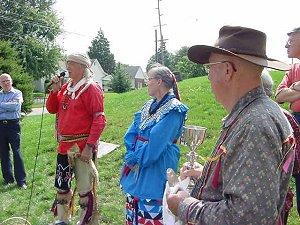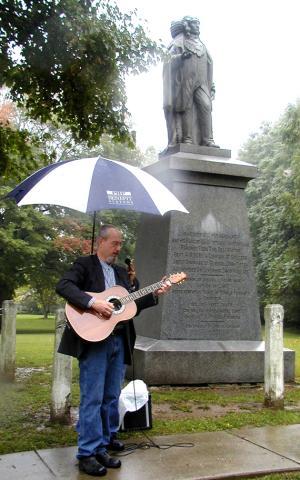|
By Shirley Willard, Fulton County Historian Traveling 660 miles is not a huge trip by today’s standards but our Trail of Death Commemorative Caravan traveled through time as well as distance. We saw the past as we stopped at the historical markers for the 1838 forced removal of the Potawatomi from Indiana to Kansas. They took 10 weeks in 1838, walking or riding horseback or wagons. We took seven days, riding in six cars, three trucks with campers and one motorhome. But the spiritual experience was vast and deep, as the members of the caravan grew to love each other and look out for each other. Some say they felt the spirits of those who died on the Trail of Death. We gave programs wherever a crowd gathered at the historical markers, using the portable speaker from FCHS. We talked to many people, telling them the true history, trying to eradicate the stereotypes and myths.
We met at the Fulton County Museum at 8 a.m. on Sept. 22 to begin the fourth Trail of Death caravan. We had planned to pray outdoors by the Father Petit memorial for a safe trip but it was raining so we had to do it in the museum lobby. It rained on us only twice during the entire trip: at Chief Menominee statue south of Plymouth and at Brunswick, Mo. At Menominee’s statue we stood under umbrellas to hear George Schricker sing the song he wrote about Chief Menominee who would not sign the treaty and sell his land. George taught us the chorus in sign language, and it was a great beginning for our trip. Mike Woolfington of the Marshall County Visitors and Convention Center welcomed us. Bill Willard went into the bushes to retrieve the Geo-caching box which contained a guest book and camera to take a group picture. Geocaching.com is a program that places boxes at historic places and then puts their visitor log on the web. Because of the rain, Menominee Elementary School did not bring its fourth graders as planned. Our only school-age visitors was a family of three kids being home-schooled by their mother.
By the time we got to the Tippecanoe River and Old 31, the first night’s camp on the 1838 emigration, it had stopped raining. At the Rochester court house Fulton County Commissioners Richard Powell and Les Walters came to greet us, and Mike Denny took a picture for the Sentinel of the four caravan members who have gone all the way on all four caravans; Sister Virginia Pearl, Kansas; Bob Pearl, Ohio, and Bill and Shirley Willard, Rochester, Ind. We ate at McDonald’s. We drove by the Mud Creek camp site on Indiana 25 and I read from the 1838 diary on the CB radio, using channel 15 for our caravan communication. At Logansport hospital a crowd gathered, including Dave Kitchell of the Pharos Tribune; Dick Copeland, Cass County Historian; and Father Philip Haslinger did the invocation. In 1838 over 300 Potawatomi were sick when they arrived at Logansport so a tent hospital was set up at the camp and they stayed three days. Ginger and Bob Pearl showed the silver chalice that Father Benjamin carried in his saddlebags on the Trail of Death for Mass and funerals every day. The chalice was used in the Mass at Logansport conducted by Bishop Brute and Father Petit on Sept. 9, 1838, the last Mass for the Potawatomi in Indiana. Petit’s chalice was on loan from the Vincennes, Indiana, church and was carried by the Pearls all the way to Kansas on the 2003 caravan. We soon fell into an ordered group with Larry Prichard bringing up the tail of the caravan. I told him this was the job of his great-great-great grandfather, William Polke, the conductor, as the records state that he often did not get into camp until 10 p.m. At age 63 in 1838 this must have been hard on Polke, so long in the saddle. Larry, a retired policeman, did a great job of looking out for all the caravaners and helping when vehicles needed attention or when people got separated and needed help to find the caravan again. At first Larry was apologetic about his ancestor, but I told him if there was a bad guy, it was General John Tipton who rounded up the Indians, burned their village and marched them out at gunpoint. I never found anything bad written about Polke - he was known as a friend of the Indians and had been a missionary to them for two years with his brother-in-law, Rev. Isaac McCoy. When Polke left the Indians in Kansas, they pleaded for him to stay so he left his son with them. When we left Logansport, we followed the Wabash River west as it winds through Cass and Carroll counties, past Trail of Death markers at Winnemac’s Old Village and at VanderVolgen’s farm, where a neighboring farm woman, Jo White, led the caravan to the TD marker at Pleasant Run near Pittsburg. We also stopped at Burnett’s Creek Arch, a boat bridge over the Wabash & Erie Canal, named for William Burnett, a fur trader and his half-Potawatomi son Abraham Burnett, who fought on the Indian side in the Battle of Tippecanoe and was given a reserve in the 1826 treaty. We visited the Trail of Death marker at the Battle Field Museum, where Kevin O’Brien, director of Tippecanoe County Historical Association, welcomed us. George Wesselhoft, another Potawatomi and cousin to Tom Hamilton, joined the caravan at Battle Ground. We drove by Burnett’s trading post, the oldest log cabin in Indiana, built c. 1790 by William Burnett. The Burnetts are the ancestors of Tom Hamilton and George Wesselhoft. At 5:00 we arrived at Mrs. Cable Ball’s house, Lafayette, to see George Winter pictures beautifully framed and hanging on her walls. Mrs. Ball was dressed in a Potawatomi dress and moccasins, seated on the sun porch. Lafayette TV reporters set up in her living room to interview the caravan members. We wandered the halls and took pictures of the Winter paintings of Father Petit and the Indians. Refreshments were laid out in the dining room. This was the high light of the day - Mrs. Ball is 97 and such a lovely lady. When we left Mrs. Ball’s house, half of our caravan went another way, got kind of lost and we did not see them again until supper. We drove to the Trail of Death markers on 500 N and Morehouse Road in Lafayette where Mr. and Mrs. Alan Morehouse came to greet us, and a neighbor woman, Jeannette Albright, gave us arrowheads to take to the Potawatomi children in Kansas. We drove next to LaGrange, site of a town that no longer exists on 950 W, where only the land owner, Mrs. Jim Crites and daughter were three to greet us. We drove on to Independence following the Wabash River, and saw deer playing in a pond. This is a lovely road past Black Rock, where Tecumseh was said to have posted guards to see if General Harrison was coming. We arrived at 7:30 p.m. at Independence a half hour late, to eat at Double K Caf?, which is usually closed on Mondays but owner Linda Klinger had prepared supper especially for our caravan. We have eaten there on all the caravans, and met old friends from those previous trips. John Henry had laid out an exhibit of the things they found from an archealogical dig at the Zachariah Cicott tradiing post. The four camping vehicles camped free at Zachariah Cicott Trading Post Park at the east edge of Independence. Those traveling in cars went to the nearest motel, the new Attica Inn. George Wesselhoft went home. George Godfrey slept in our camper on the bed that converts from a sofa, as he does during the Trail of Courage Living History Festival. George (a Ph.D. in entomology or “bug doctor”) came in with a glow worm so Bill and I went to look. There were glow worms all along one side of the road, like miniature white Christmas lights. On Tuesday Sept. 23, we heard cows mooing early from a nearby dairy farm when we woke up. We had breakfast at Double K Caf?, Independence. Owner Linda Klinger had fed us supper free last night and this morning announced that the waitresses had pooled their tips last night and paid for our breakfast. Such good hearted people we meet on the caravan! An Indian woman had made Indian ribbon shirts and placed them for sale, so Dolores and Si Grizzell, Winamac, and Pat Dockry, Minnesota, bought them and put them right on to wear for the trip. When we left, the waitresses gave us their tips ($20) to have for a treat down the road. Doris Cottingham of Warren County Historical Society led us. Sister Virginia said a prayer on the CB radio for our safety and also for greater understanding and peace among mankind. At 9:30 we visited Williamsport’s Trail of Death marker in Old Town park. A few people gathered, including Beulah Sommers, former president of Warren County Historical Society. A Danville Commercial News reporter interviewed some of the caravan members. Gopher Hill Cemetery south of Johnsonville was our next stop. Some people were waiting to greet us, including Allen Switzer, who met us in 1998, and a man named Grover, who helped Ken and Ilene Smith erect the Trail of Death marker in 1999. When we headed west, George Godfrey led the caravan into Illinois. As we drove, we talked on CB radio about making a journal with drawings like Lewis & Clark’s. We would include the deer playing in the water, a white buffalo statue, ducks, horses, blue chicory flowers along the highway, and other interesting things we saw. George is a regular encyclopedia and told us that the chicory is used for coffee. The sun was shining brightly and we missed the rain that inundated the Farm Progress Show that day at Danville. |
| < Previous | Home | Next > |

